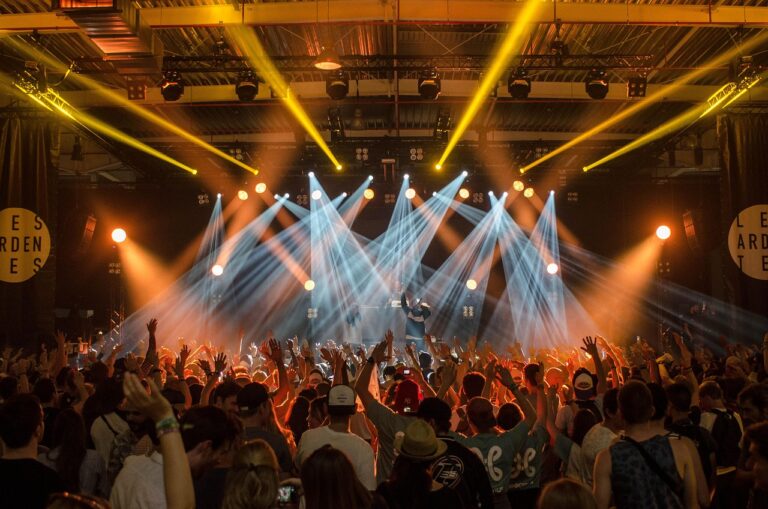Walk onto a film stage and you might see a wall with no corners: the floor curves into the wall and the wall curves into the ceiling, creating an endless horizon. Step into a 19th‑century rotunda, and you might be surrounded by a 360‑degree painting of a battlefield. Both are cycloramas designed to erase edges and make space feel bigger than it is.
If you’re asking “What is cyclorama?” in practical terms: it’s a seamless background used to create the illusion of infinity or to bathe a scene in controlled light or imagery. This guide explains types of cycloramas, how they work, how to light them, what they cost, and when to choose one over alternatives.
Definition And Origins
A cyclorama is any large, curved, edge‑less background surface that supports illusions of continuity. The term comes from Greek roots for “circle” and “view,” and historically referred to 360‑degree panoramic paintings hung inside circular buildings. Modern usage spans theater backdrops, photography “infinity coves,” and film stages that remove horizon lines and corners.
In theaters, a cyclorama (“cyc”) is often a tall, slightly curved white or gray cloth hung upstage. It’s lit with even washes or gradients to suggest sky, time of day, or abstract color. In photo and film, a cyc wall is a rigid, painted construction that blends floor‑to‑wall (and often wall‑to‑ceiling) with smooth radii, so the camera sees no seams.
Two families coexist today: pictorial cycloramas (360‑degree panoramas in museums) and production cycloramas (walls or cloth for imaging). The design intent is the same erase edges but the constraints differ. Museums prioritize viewing angles, parallax illusions, and conservation; studios prioritize even light, reflectance control, and practical durability under foot traffic.
Physical Cyclorama Walls: Shapes, Materials, And Cost
Production cycs are built to hide corners. Common shapes include L‑shaped (one corner), U‑shaped (three sides), and full “bowl” rooms. The crucial geometry is the radius of the cove: small rooms use 300–600 mm radii to conserve space; sound stages with vehicles often use 1.5–3.0 m radii to avoid visible falloff or shadowing. Heights range from 4–8 m on mid‑sized stages; still studios with 3–4 m ceilings can still benefit from a floor‑to‑wall cove.
Surface finish determines both look and lighting. Matte white paint with a low gloss (1–5 gloss units at 85°) minimizes specular hotspots. A white near Munsell N8–N9 (roughly 70–85% reflectance) is standard for “infinite white.” For neutral flexibility, many studios choose N7–N8 gray so the cyc can be lit to white, black, or color with less spill. On green‑screen cycs, chroma‑green paints are formulated for narrow spectral response and should be very matte to avoid reflections.
Materials trade permanence against portability. Permanent walls use timber or steel stud framing, double‑layer MDF or plywood skins, and skim coat plaster or fiberglass coves to achieve a continuous radius. Prefabricated fiberglass cove modules speed builds and limit cracking. Fabric cycs use flame‑retardant muslin or sharks‑tooth scrim hung from pipe battens; they store compactly and can be replaced quickly, but can crease and move with airflow unless tensioned well.
Costs vary widely by region and complexity. A permanent, paint‑ready cyc typically runs about $60–$150 per square foot installed, assuming framing, coves, sanding, and fire‑rated finishes. A modest U‑shaped cove in a small studio can land around $20,000–$80,000; large sound stages exceed six figures. A 40’×20′ flame‑retardant muslin cyc costs roughly $2,000–$5,000, plus rigging and weekly maintenance. Expect repaint and patch cycles at $3–$5 per square foot when scuffs accumulate from shoes, set pieces, or tire marks.
Lighting A Cyclorama: From Infinite White To Color Washes
Most of the “infinite” effect is achieved with light control, not just geometry. Keep subjects 3–5 m from the cyc to minimize spill and keep shadows off the background; more distance helps if you’re lighting aggressively. For high‑key white, light the background about one stop brighter than the subject and meter for clipping just below the camera’s highlight limit. For neutral gray, keep the cyc one to two stops under subject key; for black void, avoid lighting the cyc at all and flag off spill. These ratios matter because the inverse‑square law amplifies spill if subjects stand too close.
Purpose‑built cyc lights have asymmetrical reflectors to evenly throw light down the wall. A typical arrangement uses top and bottom battens spaced so each fixture’s “sweet spot” overlaps the next. As a rule of thumb, fixture spacing is about 1–1.5× the mounting distance from the surface; for a 2 m throw, place fixtures roughly 2–3 m apart. Aim for uniformity within ±0.2 stops across the camera frame to avoid visible bands. LED battens with CRI/TLCI above 95 and turndownable green‑magenta (DUV adjustments within ±0.005) will keep skin tones neutral when the cyc is in frame.
Power and heat planning still matter, even with efficient LEDs. Lighting a 6 m tall, 12 m wide cyc might use eight 150 W LED battens on the top rail and eight on the bottom 2.4 kW total. Tungsten or fluorescent rigs reach 6–10 kW for similar coverage and require more cooling. Dimming curves and flicker control should be tested at your camera’s shutter angles and frame rates; many modern LED fixtures support phase‑less dimming and genlock‑friendly modes to reduce banding.
Green‑screen work raises the tolerance bar. Evenness should be tighter within ±0.1–0.2 stops and reflections must be tamed with flags, polarizers (if compatible with the scene), and non‑specular paints. Avoid backlight shining onto the cyc, and don’t let talent stand closer than 2–3 m or you’ll fight green spill in hair and edges. Good keys depend as much on capture as paint: 10‑bit, 4:2:2 or better recording with log or RAW profiles is recommended; fine detail and motion blur are easier to key at higher shutter speeds, but beware of raising noise floors in dim setups.
When To Build, Rent, Or Simulate: Practical Alternatives
Not every project justifies a permanent cyc. Paper seamless (2.7 m/9 ft wide rolls) can create a mini‑cove by taping to the floor and wall; it’s perfect for tabletop, product, and single‑talent shots. Vinyl backdrops are more durable but can glare under hard light. A tensioned fabric cyc hung from pipe and base makes a temporary wall for events and low‑budget shoots; gaffer’s trick: add a 200–300 mm foam or soft cove at the floor junction to cheat the radius on camera.
Projection mapping onto a cyc enables backgrounds, skies, and graphical gradients without post. Use a neutral surface with gain near 1.0 to preserve color fidelity. Required projector output depends on area and target brightness. As a rough yardstick, a single 10,000‑lumen projector will deliver about 40–70 nits on a 10 m‑wide cyc in a dark stage; multiple blended projectors increase uniformity and brightness but complicate alignment and latency.
LED volumes curved walls built from modular LED panels are the most dramatic modern cyclorama twist. They render 3D environments in real time, eliminating green‑screen spill and providing physically plausible interactive light. Trade‑offs are significant: camera‑friendly pixel pitch typically needs to be 1.5–2.6 mm to avoid moiré at common focal lengths; full stages can exceed $1–$5 million including tracking, media servers, and power distribution. Synchronization to camera shutter and careful content design are essential to avoid banding, rolling‑shutter artifacts, and perspective cues that break the illusion.
Finally, consider maintenance and safety. Matte paints scuff; institute shoe covers and dedicated “cyc carts” for moving gear. Keep fire ratings in mind: fabrics should be IFR/FR treated; paints and panels should meet Class A flame spread where codes require it. Curved surfaces aren’t load‑bearing never rig to the cove; use rated truss and structural walls. Budget time for periodic skim coats to remove hairline cracks at seams, especially in climates with humidity swings.
Conclusion
In short: build or rent a cyclorama when you need seamless depth, repeatable lighting, or a flexible background that reads as white, black, or any color. Choose a permanent cove for frequent shoots with crewed loads; choose fabric or paper for portability; choose projectors or LED volumes when live backgrounds or interactive light justify the complexity. Start by fixing your geometry (radius and height), then design lighting for uniformity, and budget for upkeep the “infinite” look is surprisingly practical when engineered with these constraints in mind.



